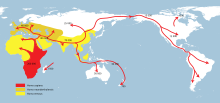Oldowan
 |
|
| Geographical range | Afro-Eurasia |
|---|---|
| Period | Lower Paleolithic |
| Dates | 2.6 million years BP – 1.7 million years BP |
| Major sites | Olduvai Gorge |
| Preceded by | Pliocene |
| Followed by | Acheulean, Riwat |
| The Paleolithic |
|---|
|
↑ Pliocene (before Homo) |
|
Lower Paleolithic (c. 3.3 Ma – 300 ka)
(300–45 ka)
(50–10 ka)
|
| ↓ Mesolithic ↓ Stone Age |
↑ Pliocene (before Homo)
The Oldowan, sometimes spelled Olduwan, is the earliest stone tool archaeological industry in prehistory. Oldowan tools were used during the Lower Paleolithic period, 2.6 million years ago up until 1.7 million years ago, by ancient hominids across much of Africa, South Asia, the Middle East and Europe. This technological industry was followed by the more sophisticated Acheulean industry.
The term "Oldowan" is taken from the site of Olduvai Gorge in Tanzania, where the first Oldowan lithics were discovered by the archaeologist Louis Leakey in the 1930s. However, some contemporary archaeologists and palaeoanthropologists prefer to use the term "Mode 1" tools to designate pebble tool industries (including Oldowan), with "Mode 2" designating bifacially-worked tools (including Acheulean handaxes), "Mode 3" designating prepared-core tools, and so forth.
Classification of Oldowan tools is still somewhat contentious. Mary Leakey was the first to create a system to classify Oldowan assemblages, and built her system based on prescribed use. The system included choppers, scrapers, and pounders. However, more recent classifications of Oldowan assemblages have been made that focus primarily on manufacture due to the problematic nature of assuming use from stone artefacts. An example is Isaac et al.'s tri-modal categories of "Flaked Pieces" (cores/ choppers), "Detached Pieces" (flakes and fragments), "Pounded Pieces" (cobbles utilized as hammerstones, etc.) and "Unmodified Pieces" (manuports, stones transported to sites). Oldowan tools are sometimes called "pebble tools", so named because the blanks chosen for their production already resemble, in pebble form, the final product.
...
Wikipedia
